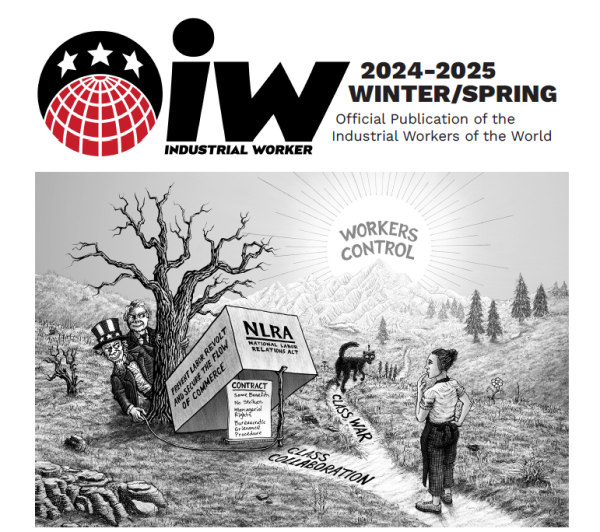The Winter-Spring 2024-2025 issue of the Industrial Worker, the blog and occasional publication of the North American Regional Administration (NARA) of the Industrial Workers of the World (IWW).

Contents include:
-Contracts are not class struggle by Jay Bettencourt
-No NLRB? No problem by x364181
-The organizer and the disorganized resistance by Daniel Bovard-Katz and Margaret Ignatowski
-Fieldnotes: Bobcats United IWW campaign by x423752
-Peet's enacts sweeping heavy-handed discipline on union members by Peet's Labor Union
-Servants in the shadows: the revolution will not be 9-5 by x423752
-The IWW "gets the goods" on a teapot dome crook by K.King
-Dedication of the IWW's monument to victims of the 1919 Centralia tragedy by x331980
-Salt is back on the table by Noah Wingard
-Too small for direct action? by x409232
Comments
Some comments regarding the …
Some comments regarding the "Contracts are not class struggle" article...
It talks a bit about the current Starbucks campaign headed by Workers United/SEIU's Starbucks Workers United (SBWU). The IWW of course, once tried to organize Starbucks from the mid-2000s until the mid-2010s through the Starbucks Workers Union (SWU).
SWU and SBWU were/are very different campaigns.
SBWU has as a goal to secure a collective bargaining agreement for either all Starbucks workers in the US or all Starbucks workers who work at locations that have won NLRB elections. They have engaged in a store-by-store NLRB election strategy that is a bit unusual and has been frowned upon by both traditional unions and the IWW in the past.
SWU's goals were to provide the training, knowledge and experience to workers and turn them into organizers to push for gains in a non-contractual manner, while utilizing ULPs...sometimes for defense, sometimes for offense. For some, this non-contractual approach was ideological. For others, it was practical. After the NLRB gave us an unfavorable ruling with Starbucks in Manhattan during the mid-2000s, it did not seem possible to go that route.
Ironically, SBWU so far has not been a success according to their own goal (they haven't yet secured a contract), but has been a success by the IWW's metrics. My guess is that there have been quite a few more Starbucks workers who have engaged in some kind of direct action or won some small localized gains with SBWU than ever did with SWU. The scale (and available resources) of SBWU is just so much larger than SWU.
The article criticizes SBWU for relying on outside support and the public. The same critique could be levied at SWU. There were a large number of walkouts and one day actions that represented a minority of the workforce at a location...sometimes only 1-2 workers. These walkouts and actions were bolstered by IWW branch members and sympathizers showing up and making up the vast majority of the picket or action that happened.
The article seems to criticize or downplay SBWU's demand and win of tips. This is curious to me, because this was a common SWU demand.
The article makes some good points about the limitations of sticking to the parameters of the labor relations system. To date, Starbucks would prefer to illegally fire workers, shut down stores, refuse to bargain in good faith and actually challenge the legitimacy of the NLRB to make it adhere to the law! The costs associated with these actions have to be astronomical. So how does a labor union make it so that it actually costs more to not seriously deal with them? In other words, if the employer refuses to accept the framework of the labor relations system and prefers to engage in illegality, how can a union succeed if it's unwilling to also engage in illegality?